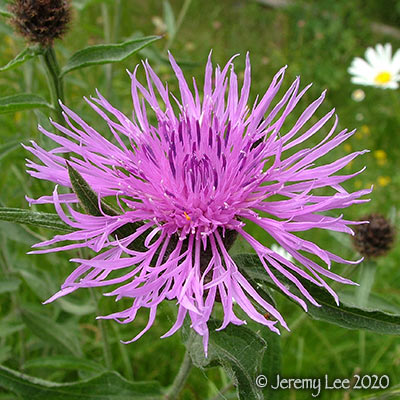
 |
|
Scientific Classifications explained » Amphibians » Ants » Aphids » Bees » Beetles » Birds » Bugs » Butterflies » Caterpillars » Damselflies » Dragonflies » Earwigs » Flies » Frog/Leafhoppers » Fungi » Galls » Grasshoppers » Harvestmen » Hoverflies » Lacewings » Ladybirds » Leaf Mines » Lichens » Mammals » Millipedes » Mosses » Moths » Sawflies » Slugs » Snails » Spiders » Trees & Shrubs » Wasps » Wild Flowers » Woodlice » Postboxes |
UK Nature > Wild Flowers > Red & Pink Wild Flowers > Centaurea scabiosa

Scientific Name: Centaurea scabiosa Common Name: Greater Knapweed Centaurea scabiosa, more commonly known as Greater Knapweed, is a thistle-like plant (it actually belongs in the sunflower family) that can be found on chalk downlands, roadside verges, woodland rides, hedgerows and clifftops. It is more restricted in its distribution than its close relative, Common knapweed, being found mainly in England on chalky soils. It is in bloom from June to September and is a huge favourite of all kinds of butterflies, including Common blues, Marbled whites and Meadow browns. The large, bright pink-purple 'flowers' of Greater Kanpweed are actually composite flower heads made up of many small 'florets' (tiny flowers). The large, ragged, star-like ones sit around the edge of the flower head and are sterile, serving only to attract insects; while the smaller, densely packed florets in the middle are fertile. It commonly grows throughout the UK and Ireland, although more prominently in England. |
|

https://www.uknature.co.uk is a website dedicated to showing the immense diversity of UK nature and wildlife. Our vast range of habitats, from lowland arable to snow covered mountains, from storm-ravaged coastlines to peaceful inland freshwater lakes and rivers, from dry, sandy heaths to deciduous and coniferous forests, all these habitats contribute to the abundance of UK nature. We have wild birds in huge numbers either residing or visiting our shores (597 recorded species as at July 2013) and we must also not forget the humble back garden with its grass lawns, flower beds filled with nectar rich flowers, shrubs and trees, all designed to attract huge numbers of insects such as bees, moths, butterflies and hoverflies; and finally the small ponds which provide safe havens for frogs, toads, newts and even slow worms and grass snakes. www.uknature.co.uk is the showcase for my personal passion, photographing uknature in all its glory. I sincerely hope you all enjoy the fruits of my labours. This site and all images contained therein is © Jeremy Lee 2004 - 2025. All Rights Reserved. Site design by Jeremy Lee. Site development & IT Support by Stuart Lee. |